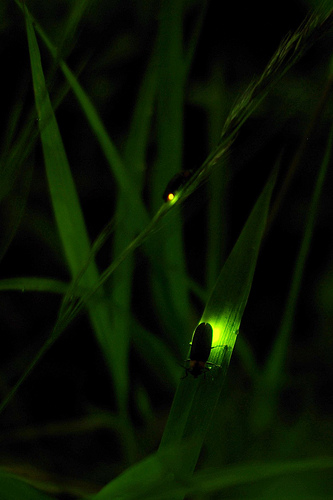Why Do Fireflies Flash?
By Chris Williams on August 4, 2014.
 Depending on your part of the country, you may call these insects fireflies or lightning bugs. We all know them from when we were children, when we used to catch them on summer evenings and put them in jars to light our bedrooms at night.
Depending on your part of the country, you may call these insects fireflies or lightning bugs. We all know them from when we were children, when we used to catch them on summer evenings and put them in jars to light our bedrooms at night.
It may surprise you to know that fireflies are actually beetles. They have wing covers like beetles but the covers are soft, not hard. Fireflies are usually seen after dusk in an open area like a field, lawn, or marsh in warm, damp regions. There are 2,000 species in the world and a couple dozen in New Hampshire and Massachusetts. We should be grateful that we can enjoy fireflies here since they are rarely seen west of Kansas.
Fireflies emit a cold light, there is no heat involved. The light is created by a chemical reaction in the firefly’s body that results in the creation of the chemicals luciferin and luciferase. The light production process is sort of a reverse fart: oxygen is taken in through the firefly’s rear end and combines with the chemicals, producing light.
It All Comes Down to Sex
Procreation is the number one reason why fireflies flash, it’s the way they attract a mate. Each firefly species has a distinguishing light pattern that helps it find and mate with one of its own species. In most species, both male and female fireflies can flash, but it’s usually the male that you see flying low over the ground, flashing “hey, baby,” “hey, baby.” An interested female, hidden in the grass, will flash back the same frequency. Eventually, they find each other.
The immature larval stage of fireflies are called “glow worms” and are interesting in their own right since they also emit light to varying degrees. The beetle larvae obviously don’t need to flash to attract a mate, they’re not sexually mature. It’s thought that the larva’s light warns possible predators that the glow worm is distasteful and full of toxic chemicals. The firefly larva lives in the ground and is a predator of earthworms and other insect larvae.
Firefly Bioluminescence Has Practical Applications
In the past, fireflies were collected for medical research. Their light has several medical uses in bioluminescent imaging. The chemicals are injected into human cells to track the progression of certain diseases. Bioluminescent imaging can also identify the presence of E. coli bacteria in water and food samples. Even the military is interested in the firefly’s light as markers for helicopter landing sites or as a way to identify troops in the field. Nowadays, the firefly’s light and the chemical process that produces it can be replicated in the lab.
For more on everything you ever wanted to know about fireflies, visit www.firefly.org
Photo credit: takot / Foter / Creative Commons Attribution 2.0 Generic (CC BY 2.0)